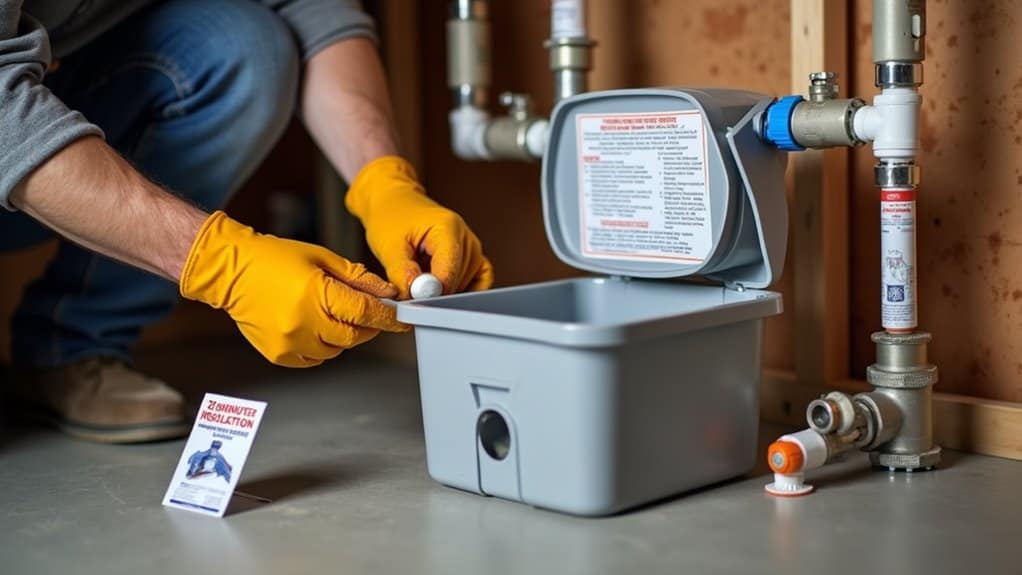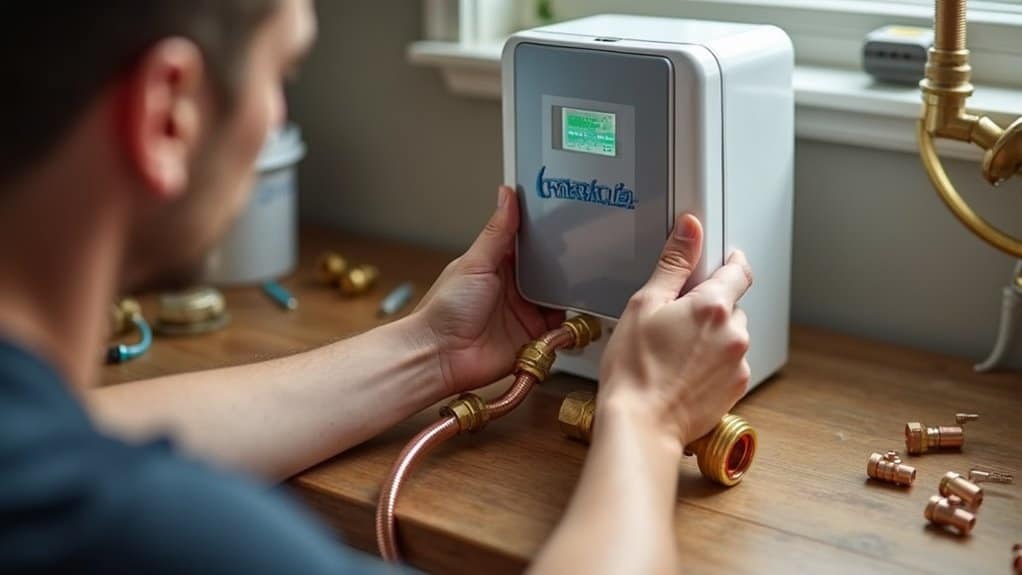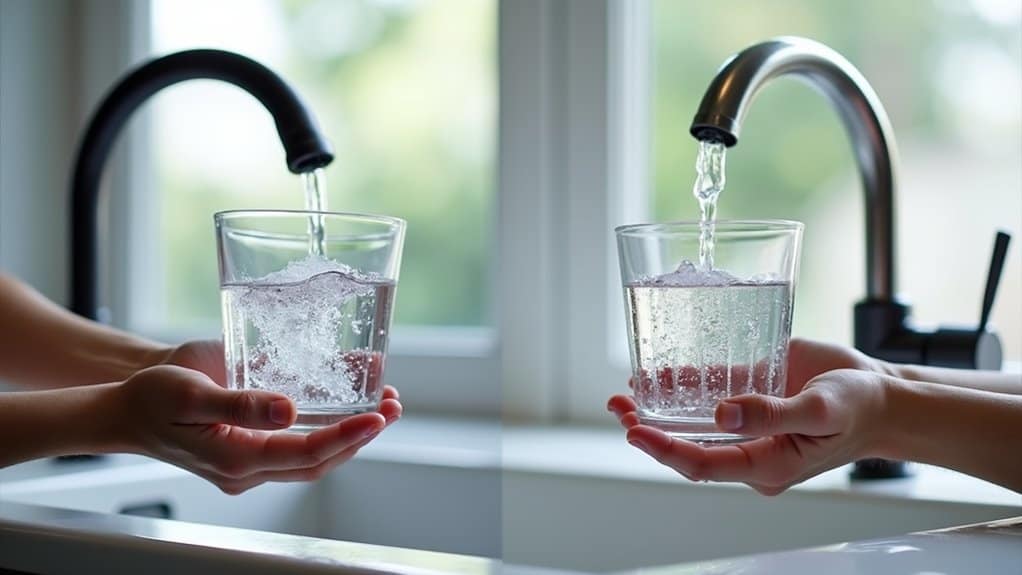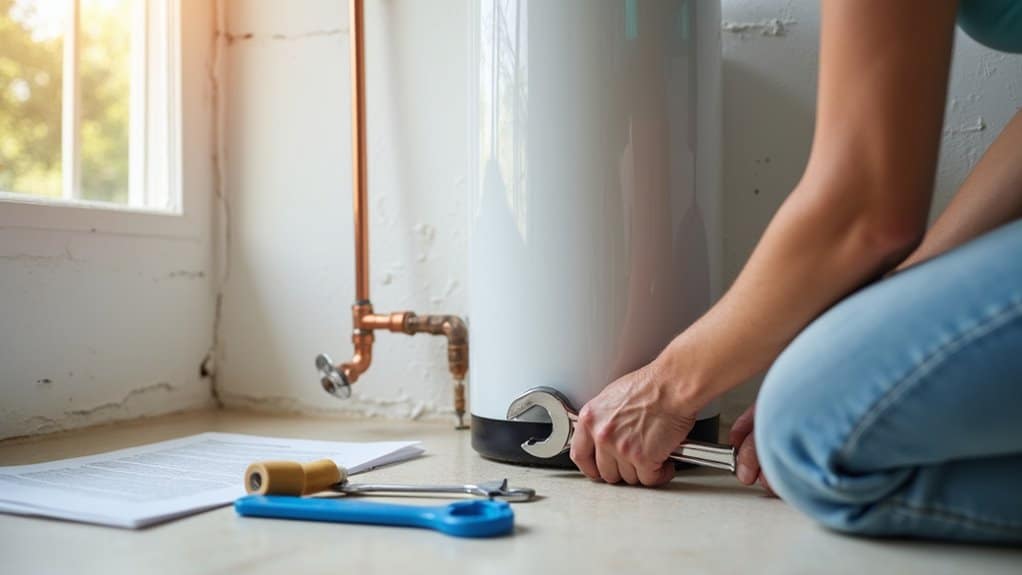Modern water softener installations have been revolutionized by push-to-connect technology like SharkBite fittings. We can now bypass professional plumbers, soldering, and specialized tools entirely. With just a few simple steps—shutting off water, positioning the unit, connecting pipes with push fittings, and adding salt—you’ll have a fully functional system in under 20 minutes. The process works with various pipe materials and delivers immediately noticeable results. Our step-by-step guide shows exactly how.
Key Takeaways
- SharkBite push-to-connect fittings eliminate soldering and gluing, allowing anyone to install a water softener quickly.
- Installation requires only shutting off water, positioning the softener, and using push-connect fittings for plumbing connections.
- The simple five-step process can be completed in 20 minutes without specialized plumbing knowledge or tools.
- Modern water softeners with bypass valves simplify installation in tight spaces where traditional methods would be challenging.
- DIY installations provide the same benefits as professional setups, including softer water and reduced mineral residue.
Why Traditional Water Softener Installations Are Unnecessarily Complicated

While many homeowners dream of soft water’s benefits, traditional water softener installations have become needlessly complex, expensive, and frustrating.
We’ve seen too many installations derailed by unreasonable requirements: licensed professionals handling both plumbing and electrical work, precise drain configurations with air gaps, dedicated outlets, and complex bonding between pipes. Additionally, some high-end systems can inadvertently lead to hidden risks for residential plumbing, causing further complications.
The space demands alone are prohibitive for many homes.
Common defects like improper drain hose routing, extension cord usage, and missing pre-filters further complicate matters. Loose connections can lead to leaks near the base, creating additional water damage concerns.
Add in ongoing maintenance headaches like salt bridges and backwashing, and it’s no wonder many homeowners abandon the idea altogether.
The SharkBite Revolution: How Modern Fittings Changed Everything

The water softener landscape has undergone a remarkable transformation with the introduction of SharkBite and similar push-to-connect fittings.
These innovations eliminate soldering and gluing while requiring half the insertion effort of first-generation products. Additionally, DIY installation has become more accessible to homeowners, making it easier to tackle water softener setups without professional help.
We’ve found these fittings particularly game-changing because they seamlessly connect different pipe materials—copper, PEX, CPVC, and HDPE—without specialized tools.
Their compact design works in tight spaces where traditional methods fail, while stainless steel reinforcing collars ensure long-term durability with twice the burst pressure of older models. The Max Brass connector can be installed on wet lines and pressure tested immediately for faster project completion.
Best of all, they’re code-approved for underground and behind-wall installations, completely simplifying water softener connections.
Step-By-Step: Your 20-Minute Installation Guide

Installing a water softener system has never been easier with today’s modern fittings and simplified design.
We’ll guide you through the quick setup process that saves both time and money.
First, shut off your main water supply and position the softener near a drain and electrical outlet.
Next, attach the bypass valve to your main water line using Teflon tape on all threaded connections.
- Use SharkBite or push-to-connect fittings to link your plumbing without soldering. This innovation allows for easy plumbing connections that eliminate the need for specialized tools or skills.
- Fill the brine tank halfway with salt pellets (30-40 lbs).
- Run water for 5 minutes to flush the system before normal use.
This installation can help protect your investment by preventing scale build-up on appliances and plumbing fixtures.
Real Homeowner Results: Before and After The DIY Approach

Many homeowners report dramatic differences after completing their own water softener installations, contrary to what professional installers might suggest. When done correctly, DIY installations lead to noticeably softer water, reduced soap usage, and elimination of mineral residue in sinks and showers. Additionally, many homeowners discover that quality water softeners can significantly reduce the frequency of service calls, which is often overlooked by contractors.
However, real results depend on proper execution. Homeowners who rush through complex plumbing connections or misconfigure settings often face leaks, contamination risks, or continued hard water problems. DIY installation may result in voided warranty coverage if not performed according to manufacturer specifications.
Proper sizing based on household water usage is critical—undersized units won’t perform effectively, while oversized ones waste resources. The true before-and-after difference isn’t just in water quality, but in appliance longevity and scale reduction throughout your home.
Frequently Asked Questions
Will a Water Softener Affect My Water Pressure?
We’ve found properly sized water softeners maintain normal pressure. However, undersized units, clogged components, or mechanical failures can decrease flow. Regular maintenance ensures optimal performance through your plumbing system.
Is Softened Water Safe for Gardens and Plants?
We don’t recommend using softened water for plants. The sodium residues harm roots and build up in soil. Instead, use a bypass valve for outdoor taps or dilute with rainwater for houseplants.
How Often Do I Need to Add Salt/Potassium?
We recommend adding salt every 4-6 weeks for most households. Check monthly to keep levels between 1/4 and 3/4 full, always above the water line. High usage homes should check twice monthly.
Can I Install This System in an Outdoor Setting?
Yes, we can install this outdoors in warm regions with proper protection. We’ll need a shed or insulated cabinet, UV cover, elevated platform, and access to power, drain, and regular maintenance.
What’s the Difference Between Salt-Based and Salt-Free Systems?
We offer both systems. Salt-based removes calcium/magnesium through ion exchange, requiring salt refills but eliminating 100% of scale. Salt-free uses TAC, needs no salt maintenance, but only reduces scale buildup.
Conclusion
We’ve shown that modern water softener installation doesn’t require professional help or complicated plumbing work. With SharkBite fittings and our straightforward guide, you’ll save hundreds while completing the job in just 20 minutes. The before-and-after results speak for themselves—better-tasting water, extended appliance life, and softer laundry. Don’t let outdated installation myths keep you from enjoying the benefits of soft water throughout your home.

Craig “The Water Guy” Phillips is the founder of Quality Water Treatment (QWT) and creator of SoftPro Water Systems.
With over 30 years of experience, Craig has transformed the water treatment industry through his commitment to honest solutions, innovative technology, and customer education.
Known for rejecting high-pressure sales tactics in favor of a consultative approach, Craig leads a family-owned business that serves thousands of households nationwide.
Craig continues to drive innovation in water treatment while maintaining his mission of “transforming water for the betterment of humanity” through transparent pricing, comprehensive customer support, and genuine expertise.
When not developing new water treatment solutions, Craig creates educational content to help homeowners make informed decisions about their water quality.


